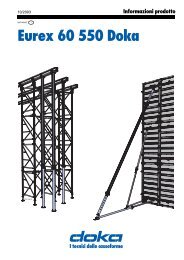Quality and what it involves - Doka
Quality and what it involves - Doka
Quality and what it involves - Doka
You also want an ePaper? Increase the reach of your titles
YUMPU automatically turns print PDFs into web optimized ePapers that Google loves.
<strong>Qual<strong>it</strong>y</strong> <strong>and</strong><br />
<strong>what</strong> <strong>it</strong> <strong>involves</strong><br />
International S<strong>it</strong>e Review<br />
1/2000<br />
<strong>Doka</strong> self-climbing formwork<br />
at the Verrieres viaduct.
Formwork News 1|2000<br />
2<br />
<strong>Qual<strong>it</strong>y</strong> <strong>and</strong> <strong>what</strong> <strong>it</strong> <strong>involves</strong><br />
At the beginning of the 21 st century,<br />
the construction industry is confronted<br />
w<strong>it</strong>h fierce compet<strong>it</strong>ion that obliges<br />
contractors to achieve the very maximum<br />
in performance, in an increasingly<br />
international environment.<br />
In this s<strong>it</strong>uation, the contractor more<br />
than ever needs a reliable formwork<br />
partner - one who will not only supply<br />
modern equipment,<br />
but also the knowhow<br />
about using this<br />
equipment in the most<br />
efficient way. W<strong>it</strong>h the<br />
ever-shorter construction<br />
periods allowed<br />
nowadays, <strong>it</strong> is more<br />
important than ever<br />
for the formwork<br />
Alfred Zimmermann equipment to be<br />
available quickly<br />
when <strong>it</strong> is needed <strong>and</strong> - where required -<br />
for formwork un<strong>it</strong>s to be delivered preassembled.<br />
For <strong>Doka</strong>, “Just in time” is<br />
qu<strong>it</strong>e the oppos<strong>it</strong>e of a hollow buzzword,<br />
but is an everyday working real<strong>it</strong>y.<br />
For <strong>Doka</strong>, however, customer service<br />
does not finish when the goods are<br />
delivered. Far from <strong>it</strong> - for delivery<br />
simply marks the start of the after<br />
sales service which in many cases,<br />
particularly w<strong>it</strong>h more complex projects,<br />
can have a crucial influence on the<br />
prof<strong>it</strong>abil<strong>it</strong>y of the s<strong>it</strong>e. W<strong>it</strong>h <strong>it</strong>s technical<br />
advisory services <strong>and</strong> detailed resource<br />
scheduling, <strong>Doka</strong> streamlines the<br />
client’s forming sequences <strong>and</strong> ensures<br />
that the formwork is used in the most<br />
cost-effective way.<br />
In add<strong>it</strong>ion, <strong>Doka</strong> can provide training<br />
for s<strong>it</strong>e personnel, <strong>and</strong> a comprehensive<br />
supervising-foreman service for the s<strong>it</strong>e.<br />
Here, an experienced <strong>Doka</strong> expert is on<br />
h<strong>and</strong> to supervise the s<strong>it</strong>e crew when<br />
they assemble <strong>and</strong> use the formwork<br />
for the first time, but also to help w<strong>it</strong>h<br />
any modifications that may be needed<br />
to the formwork.<br />
W<strong>it</strong>h <strong>it</strong>s dependable formwork<br />
systems <strong>and</strong> comprehensive range of<br />
service offerings, <strong>Doka</strong> gives the building<br />
industry the tools <strong>it</strong> needs to get<br />
optimum forming results <strong>and</strong> a smooth,<br />
trouble-free construction sequence.<br />
Alfred Zimmermann<br />
Vice President Deutsche <strong>Doka</strong><br />
Formwork Challenge<br />
on French Viaduct<br />
The 720 m Verrieres viaduct features a radius curve of 1800 m<br />
<strong>and</strong> has five supporting piers (P1 - P5), two large abutments<br />
<strong>and</strong> a bridge deck - which will be ‘pushed’ across the completed<br />
piers from one side of the valley.<br />
An impressive element of the Verrieres viaduct will be <strong>it</strong>s<br />
supporting piers, particularly the two central piers P2 <strong>and</strong> P3<br />
which will both be 140 m high. To enhance the aesthetic<br />
appearance of the viaduct <strong>it</strong> has been designed such that all <strong>it</strong>s<br />
piers have the same cross section at any given elevation.<br />
T<br />
wo sets of <strong>Doka</strong> self-climbing<br />
formwork totalling 750 m2 have<br />
been supplied for the project’s main<br />
joint venture contractor comprising<br />
Spie Batignolles, Razel, SOGEA,<br />
Dodin Sud <strong>and</strong> Victor Buyck.<br />
Piers P1, P4 <strong>and</strong> P5 are all conical<br />
in shape over their complete height,<br />
as are the top sections of P2 <strong>and</strong> P3.<br />
Where these two piers differ however<br />
is for the first 50 m w<strong>it</strong>h a<br />
parabola profile. Whilst certainly<br />
pleasing to the eye, according<br />
to Herwig Steininger, General<br />
Manager of <strong>Doka</strong> France, the design<br />
posed a few headaches for the<br />
formwork designer.<br />
“It was this complex<strong>it</strong>y of design,<br />
working w<strong>it</strong>hin a tight schedule w<strong>it</strong>h<br />
minimal production losses, <strong>and</strong><br />
lim<strong>it</strong>ed manpower that made the<br />
project so dem<strong>and</strong>ing <strong>and</strong> one of<br />
the most difficult to date,“ added<br />
Mr. Steininger.<br />
In order for the finished concrete<br />
to follow the parabolic profile, a<br />
formwork system was required<br />
where individual panels could be<br />
connected <strong>and</strong> packed securely to<br />
the overall support system.<br />
Designing the overall system at <strong>it</strong>s<br />
headquarters in Amstetten, Austria,<br />
<strong>Doka</strong> incorporated as much<br />
preassembled componentry as<br />
possible, to ensure that both<br />
One of two 140 m high piers where<br />
<strong>Doka</strong> self-climbing formwork is used.
On completion of each four metre lift<br />
of concreting the <strong>Doka</strong> self-climbing<br />
formwork has to be adapted.<br />
Contents<br />
<strong>Doka</strong> know-how for Brazilian<br />
cable-stayed bridge<br />
T<br />
he Ponte St. Amaro railway<br />
bridge in São Paulo is Brazil’s -<br />
<strong>and</strong> <strong>Doka</strong> Brasil’s - second cablestayed<br />
suspension bridge. The<br />
<strong>Doka</strong> team came up w<strong>it</strong>h a formwork<br />
solution of convincing qual<strong>it</strong>y.<br />
For the 68.70 m tall tower, <strong>Doka</strong><br />
climbing formwork 150 F w<strong>it</strong>h<br />
large-area formwork Top 50 is<br />
being used alternately w<strong>it</strong>h dam<br />
formwork. Above the 18 m mark,<br />
the casting steps (each 2.40 m) are<br />
executed w<strong>it</strong>hout through-ties. The<br />
towers taper from 7.0 m x 2.0 m to<br />
5.5 m x 2.0 m.<br />
The 117.90 m long free-cantilevered<br />
section of the bridge superstructure<br />
is being cast in 6.50 m<br />
long sections formed using <strong>Doka</strong><br />
Top 50.<br />
“When <strong>it</strong> comes to challenging<br />
projects in the field of transportation<br />
infrastructure, all paths lead to<br />
our door“, notes a satisfied Günter<br />
Le<strong>it</strong>ner, Managing Director of <strong>Doka</strong><br />
Brasil. ■<br />
Contractors: OAS<br />
formwork systems could be adapted<br />
as quickly as possible. This was<br />
achieved by pre-planning all the<br />
changes required for the subsequent<br />
climb upwards.<br />
Herwig Steininger confirms,<br />
“The design process was extremely<br />
complex in order to ensure simple<br />
use of the system on-s<strong>it</strong>e“.<br />
According to project director<br />
Vincent Preysass, <strong>Doka</strong> undertook<br />
to guarantee lifting sections on the<br />
conical elements in three days. “In<br />
practice,“ he adds, “we have been<br />
achieving average cycles of just<br />
two days w<strong>it</strong>h a work force manpower<br />
of only nine people“. ■<br />
Contractors: Spie Batignolles, Razel, SOGEA,<br />
Dodin Sud <strong>and</strong> Victor Buyck<br />
Page<br />
Piers <strong>and</strong> superstructure w<strong>it</strong>h <strong>Doka</strong> 4<br />
Difficult formwork assignment<br />
mastered w<strong>it</strong>h <strong>Doka</strong> 4<br />
“Climbed“ w<strong>it</strong>h Framax 5<br />
Economically <strong>and</strong> fast – w<strong>it</strong>h Framax 5<br />
Tunnel formwork à la carte 6<br />
Ahead of schedule w<strong>it</strong>h<br />
<strong>Doka</strong> systems 8<br />
Accelerated construction sequence 8<br />
270,000 m 2 of floor slabs<br />
w<strong>it</strong>h <strong>Doka</strong>flex tables 9<br />
Successful reconstruction<br />
w<strong>it</strong>h <strong>Doka</strong> 9<br />
World s<strong>it</strong>e round-up 10<br />
Setting new st<strong>and</strong>ards in<br />
automatic climbing technology 12<br />
Formwork News 1|2000<br />
3
Formwork News 1|2000<br />
4<br />
Shin Tanyang Bridge, Korea<br />
Piers <strong>and</strong> superstructure w<strong>it</strong>h <strong>Doka</strong><br />
K<br />
orea’s new Central Highway will<br />
greatly improve the infrastructure<br />
of the east of the country. The<br />
motorway crosses mountain ranges<br />
<strong>and</strong> very many rivers. On the Shin<br />
Storda Bridge, Norway<br />
Tanyang Bridge, two of the four<br />
pairs of piers rise straight out of the<br />
water to a height of around 85 m.<br />
In collaboration w<strong>it</strong>h the selfclimbing<br />
specialists from <strong>Doka</strong> HQ<br />
in Amstetten, the project engineers<br />
from Kumkang <strong>Doka</strong> came up w<strong>it</strong>h<br />
an “all-in-one” formwork concept,<br />
including free cantilevering, for the<br />
whole bridge.<br />
The advantage for the customer:<br />
The individual construction<br />
sequences could be optimised,<br />
which also meant that the material<br />
was used in the most efficient way.<br />
The ingenious solution required<br />
only a small number of simple<br />
system elements. As the pairs of<br />
piers taper upwards conically, a<br />
telescoping shaft-platform solution<br />
w<strong>it</strong>h Top 50 formwork was<br />
developed for the inside formwork,<br />
which automatically adapts to the<br />
tapering cross-section.<br />
On the outside, the formwork<br />
was “climbed” w<strong>it</strong>hout a crane, by<br />
SKE 50 automatic climbers. Here<br />
too, a telescoping platform solution<br />
was used to automatically adapt<br />
the formwork to the shorter crosssections.<br />
For the free cantilevering<br />
work, Kumkang <strong>Doka</strong> also delivered<br />
a total of 16 scaffold carriages<br />
as part of the deal. ■<br />
Contractors: Dong Bu<br />
Difficult formwork assignment mastered w<strong>it</strong>h <strong>Doka</strong><br />
T<br />
he high adaptabil<strong>it</strong>y <strong>and</strong> ease of<br />
assembly of the <strong>Doka</strong> formwork<br />
were particularly appreciated by the<br />
contractors NCC Anlegg AS in the<br />
work on the superstructure of the<br />
Storda Bridge.<br />
The <strong>Doka</strong> superstructure formwork<br />
was made up of 66 preassembled<br />
5 m un<strong>it</strong>s, greatly<br />
facil<strong>it</strong>ating the work of erecting <strong>and</strong><br />
lifting the formwork. The <strong>Doka</strong><br />
transport fork proved most useful<br />
here, as <strong>it</strong> made for very fast <strong>and</strong><br />
easy h<strong>and</strong>ling of these assembly<br />
elements. ■<br />
Contractors: NCC Anlegg AS
“Climbed“<br />
w<strong>it</strong>h Framax<br />
T<br />
hree walls, each 120 m long <strong>and</strong><br />
22 m high, w<strong>it</strong>h stiffening ribs at<br />
regular intervals, were constructed<br />
in a particularly efficient manner<br />
using climbing formwork MF 240 in<br />
conjunction w<strong>it</strong>h Framax. The formwork<br />
operations here were carried<br />
out for a warehouse in Metz,<br />
France, by BDW / Quillery. ■<br />
Contractors: BDW / Quillery<br />
Economically <strong>and</strong> fast – w<strong>it</strong>h Framax<br />
O<br />
nly 2 months were available<br />
for the construction of the<br />
service-water reservoir <strong>and</strong> cleaning<br />
tank of Inchon Airport, Korea.<br />
One-third of the tank, which has a<br />
capac<strong>it</strong>y of 16,200 m 2 of water, is<br />
criss-crossed by transversal bulkhead<br />
walls.<br />
3000 m 2 of <strong>Doka</strong> framed formwork<br />
Framax were used to form<br />
this 30 m x 90 m tank, w<strong>it</strong>h <strong>it</strong>s 6 m<br />
tall outside walls. On schedule! ■<br />
Contractors: Chang Il<br />
Formwork News 1|2000<br />
5
Formwork News 1|2000<br />
6<br />
Tunnel formwork à la carte<br />
Rectangular tunnel being built at St. Anton-am-Arlberg railway station in<br />
Austria using the cut-<strong>and</strong>-cover method <strong>and</strong> unusual forming cycles. Of the 3<br />
load-bearing tower un<strong>it</strong>s w<strong>it</strong>h the straight slab-formwork elements, the ones on<br />
the outside are left st<strong>and</strong>ing as temporary shoring.<br />
An example of <strong>what</strong> the Swiss like about Holzco-<br />
<strong>Doka</strong>’s tunnel solutions: Here we see a portal<br />
carriage solution for the noise abatement gallery at<br />
Leutzigen, w<strong>it</strong>h a section length of a huge 20 m, a<br />
width of 11.70 m <strong>and</strong> attached tilting elements that<br />
add another 2 m to the width. The whole construction<br />
is lowered by 10 lowering wedges on each side,<br />
<strong>and</strong> moved ahead on 4 sets of heavy-duty rollers.<br />
A complete solution for a light-railway tunnel at<br />
Munich Airport: A Staxo load-bearing tower un<strong>it</strong><br />
carries the cover-slab formwork, consisting of readyassembled<br />
elements of <strong>Doka</strong> wall formwork FF 20<br />
from which the side-wall formwork is suspended.<br />
After the tower-rows have been lowered, the f<strong>it</strong>tingstrip<br />
has been removed <strong>and</strong> the outside towers have<br />
been drawn in towards the middle, the entire crosssection<br />
is moved ahead to the next section.<br />
M<br />
ore than w<strong>it</strong>h any other type of<br />
civil engineering project, <strong>it</strong> is<br />
tunnel construction s<strong>it</strong>es whose<br />
success depends on the chosen<br />
formwork solution, from the point of<br />
view of both h<strong>and</strong>ling <strong>and</strong><br />
efficiency. When the <strong>Doka</strong> Formwork<br />
Experts moved into the tunnelformwork<br />
field some 25 years ago,<br />
this was mainly dominated by the<br />
steel-formwork traveller, i.e. by<br />
special tunnel-forming machines.<br />
<strong>Doka</strong>’s idea was to introduce lowcost<br />
st<strong>and</strong>ard components from <strong>it</strong>s<br />
wall <strong>and</strong> floor formwork ranges.<br />
Element-type wall formworks or<br />
even ready-assembled formworks,<br />
for example. Or falsework solutions<br />
from the <strong>Doka</strong> bridge-building range<br />
- <strong>and</strong> load-bearing tower un<strong>it</strong>s from<br />
<strong>Doka</strong>’s experience w<strong>it</strong>h heavy floor<br />
slabs. All these have the advantage<br />
that these formworks now start to<br />
pay off even after only a few times<br />
of use (i.e. forming-sections). Not<br />
just because these st<strong>and</strong>ard parts<br />
are in any case cheaper <strong>and</strong> easier<br />
to install, but also because of their<br />
high degree of reusabil<strong>it</strong>y.<br />
At first, the cross-sectional adjustments<br />
were made using e.g.<br />
adapted steel walings. Later, special<br />
plates were used to bolt st<strong>and</strong>ard<br />
walings together as falsework to<br />
make portal frames. This has the<br />
advantage of leaving generous<br />
access openings for s<strong>it</strong>e traffic.
Then <strong>Doka</strong> engineers h<strong>it</strong> on the<br />
idea of placing supporting construction<br />
frames (as used in singlesided<br />
formwork) on their heads <strong>and</strong><br />
using them as “pre-fabricated <strong>and</strong><br />
ready-to-use“ load-bearing assemblies.<br />
For the tunnel roof <strong>and</strong> sidewall<br />
formwork, there is now a<br />
“collection“ of st<strong>and</strong>ardised struts<br />
for supporting the formwork <strong>and</strong><br />
making the final shape adjustments.<br />
This principle also applies<br />
to the latest development: A complete<br />
portal-frame solution w<strong>it</strong>h Vshaped<br />
columns as a load-bearing<br />
un<strong>it</strong>. The result is a tunnel formwork<br />
which - depending on the<br />
type of superstructure <strong>it</strong> is completed<br />
w<strong>it</strong>h - can be used for both the<br />
cut-<strong>and</strong>-cover technique <strong>and</strong> the<br />
mining technique. Assembly by the<br />
“<strong>Doka</strong> Ready-to-Use Service“, i.e.<br />
pre-assembly of still-transportable<br />
un<strong>it</strong>s, means much lower assembly<br />
costs than would be the case for<br />
on-s<strong>it</strong>e assembly.<br />
All in all, these ideas - that is,<br />
putting together tunnel formworks<br />
“à la carte“ - make for optimum<br />
h<strong>and</strong>ling, w<strong>it</strong>h labour savings when<br />
<strong>it</strong> comes to plumbing <strong>and</strong> shifting.<br />
Not to mention the attractive material<br />
<strong>and</strong> assembly costs, which mean<br />
that the equipment pays off after<br />
only a very few consecutive uses!<br />
Another <strong>Doka</strong> development that<br />
favours larger assembly-un<strong>it</strong>s is the<br />
articulated connecting plate for<br />
polygonal linking of steel walings<br />
at exactly defined angles. This component<br />
makes <strong>it</strong> possible to accommodate<br />
any desired shape, <strong>and</strong> can<br />
be re-adjusted <strong>and</strong> re-used again<br />
<strong>and</strong> again. ■<br />
The 110 m long Smecka Tunnel in<br />
Slovenia was built in 10 m sections,<br />
in weekly cycles. The entire inside<br />
formwork was shifted here in just<br />
half a day each time. After the<br />
tunnel forming operations had<br />
been finished, the versatile <strong>Doka</strong><br />
equipment was dismantled <strong>and</strong><br />
re-used in a new configuration for<br />
an underground water reservoir.<br />
<strong>Doka</strong> tunnel formwork for an underground railway station in Milan: The traveller<br />
for the underground concourse is constructed from <strong>Doka</strong> supporting construction<br />
frames ‘Universal’, as normally used for single-sided wall formworks. Placed<br />
upside down <strong>and</strong> bolted together w<strong>it</strong>h steel walings, these carry both the strutsupported<br />
roof-arch formwork <strong>and</strong> the side-wall formwork. This means that the<br />
whole construction is largely assembled from st<strong>and</strong>ard components. Note how<br />
much space the wide drive-through opening leaves for s<strong>it</strong>e traffic.<br />
From cut-<strong>and</strong>-cover to semi-open to mining: On the Fuchsloch Tunnel under Austria’s<br />
Arlberg pass, the formwork cross-section w<strong>it</strong>h the load-bearing portal frame solution<br />
is structured in such a way that <strong>it</strong> can cope w<strong>it</strong>h the formwork pressure <strong>and</strong> w<strong>it</strong>h all<br />
other loads. Nevertheless: The whole thing only uses st<strong>and</strong>ard parts!<br />
7
Formwork News 1|2000<br />
8<br />
Ahead of schedule w<strong>it</strong>h <strong>Doka</strong> systems<br />
40,000 m 2 of floor slab had to be<br />
formed on the main building of<br />
the Health Sciences Centre,<br />
Jabriah Campus, Kuwa<strong>it</strong>, <strong>and</strong><br />
shored at heights ranging from<br />
4.20 m to 6.05 m.<br />
W<br />
hile <strong>Doka</strong>flex (w<strong>it</strong>h a commissioning<br />
quant<strong>it</strong>y of 3000 m2 )<br />
was used for heights of up to approx.<br />
5 m, floor-slabs at greater heights<br />
B<br />
oth material <strong>and</strong> labour costs<br />
were saved in the construction<br />
of a 13-storey residential <strong>and</strong> office<br />
building in Bratislava, Slovakia,<br />
thanks to the optimised floor-formwork<br />
concept employed here. The<br />
use of <strong>Doka</strong>flex tables on the typical<br />
storeys perm<strong>it</strong>ted fast formwork<br />
erection <strong>and</strong> shifting times, <strong>and</strong> the<br />
4-day cycle kept the material costs<br />
low. After the formwork was struck,<br />
the new floor-slab only needed to<br />
be re-propped w<strong>it</strong>h re-shoring<br />
props. In this way <strong>it</strong> was possible<br />
not only to achieve a rapid forming<br />
sequence, but also to place a lim<strong>it</strong><br />
on the material costs. ■<br />
than this were shored w<strong>it</strong>h d2 loadbearing<br />
towers. Thanks to a highly<br />
ingenious design concept, <strong>it</strong> was<br />
possible to use the same floor-formwork<br />
superstructure in both cases.<br />
On all the waffle slabs, incidentally,<br />
<strong>it</strong> was decided to dispense<br />
w<strong>it</strong>h formwork sheeting <strong>and</strong> place<br />
the waffles directly onto the formwork<br />
beams. Another impressive<br />
feature is the huge number of piers<br />
- 1100 in all - that are being formed<br />
w<strong>it</strong>h just 17 sets of Top 50 column<br />
formwork.<br />
Project manager Ahmed Al-<br />
Taher confirms that thanks to the<br />
adaptable, use-anywhere <strong>Doka</strong><br />
formworks, the building work is<br />
actually progressing ahead of<br />
schedule - desp<strong>it</strong>e the fact that<br />
there were delays in starting the<br />
concrete works. ■<br />
W<strong>it</strong>h <strong>Doka</strong> formwork systems, the building work is actually progressing ahead of schedule at the Health Sciences<br />
Centre, Jabriah Campus, Kuwa<strong>it</strong>.<br />
Accelerated construction sequence<br />
Contractors: BCI Z ˇ ilina, Bratislava
270,000 m 2 of floor slabs<br />
w<strong>it</strong>h <strong>Doka</strong>flex tables<br />
T<br />
o refer to the new Transportation<br />
Centre at Korea’s br<strong>and</strong>-new<br />
Inchon Airport as just a “station“<br />
would be a gross understatement.<br />
Up to 5 storeys high <strong>and</strong> w<strong>it</strong>h<br />
270,000 m2 of covered space, this<br />
structure will be nothing less than a<br />
complete intermodal transportation<br />
interchange facil<strong>it</strong>y.<br />
The structure’s varying storey<br />
heights (from 3.6 m up to 10 m) <strong>and</strong><br />
interlocking layouts made <strong>it</strong> ideal<br />
for using <strong>Doka</strong>flex tables. The 3<br />
main floor slabs have a floor-beam<br />
in the same pos<strong>it</strong>ion every 8 m.<br />
Cast-in-s<strong>it</strong>u columns are spaced<br />
every 10 m. In order to keep the<br />
quant<strong>it</strong>ies of material required<br />
down to a total of 12,000 m2 of<br />
tables, every table-leg had to carry<br />
up to 35 kN.<br />
Logically divided up into fields of<br />
80 m2 each, the entire floor-slab<br />
formwork was solved by the <strong>Doka</strong><br />
Formwork Experts using a single<br />
table-format. The cast-in-s<strong>it</strong>u columns<br />
were formed w<strong>it</strong>h 28 sets of Top 50<br />
column formwork, <strong>and</strong> the walls<br />
w<strong>it</strong>h approx. 1250 m2 of Top 50.<br />
Tableforms are not commonly<br />
used in Korea. Nevertheless, the<br />
s<strong>it</strong>e found that a “specimen plan“<br />
for a 2000 m2 area of floor-slab was<br />
perfectly sufficient. In the first<br />
phase of work, <strong>and</strong> then in all sub-<br />
sequent phases, 6000 m 2 of tables<br />
were erected w<strong>it</strong>h reference to this<br />
plan, even though building contractors<br />
in Korea normally insist on<br />
detailed plans. After a 10-month<br />
Successful reconstruction<br />
w<strong>it</strong>h <strong>Doka</strong><br />
I<br />
n the course of extensive renovation<br />
work, 6 completely new<br />
floor slabs had to be built in a<br />
historic property in Dublin’s College<br />
Street. For this assignment, the<br />
Irish contractors L&S Development<br />
construction period, the shell of<br />
the structure was completed on<br />
schedule. ■<br />
Contractors: Samsung, Chang Il<br />
used <strong>Doka</strong>flex tables, which perm<strong>it</strong>ted<br />
highly efficient erection <strong>and</strong><br />
shifting of the formwork. The tables<br />
were moved out into a central inside<br />
courtyard from where they could<br />
then easily be lifted to the next storey.<br />
Formwork News 1|2000<br />
9
Formwork News 1|2000<br />
10<br />
Streamlined forming<br />
operations in Sharjah<br />
T<br />
he Juma Al Majid Residential Complex in Al Nahda, Sharjah, U.A.E., consists<br />
of two 29-storey towers. The project is being formed using 9400 m2 of<br />
<strong>Doka</strong>flex tables for the floors <strong>and</strong> 3400 m 2 of Top 50 formwork for the walls. ■<br />
Precision automatic climbing<br />
assignment in Minneapolis<br />
When complete, this 128 m high 32-storey tower in the heart of<br />
downtown Minneapolis, Minnesota, will contain over 93,000 m 2 of<br />
parking <strong>and</strong> leasable retail <strong>and</strong> office space <strong>and</strong> will house two of<br />
the area’s most prestigious advertising <strong>and</strong> law corporations.<br />
Contractors: ECC Mowlem Joint Venture<br />
I<br />
n total, the office tower concrete<br />
core consists of four nearly<br />
equal-size cells, which combine to<br />
around 35 m in length <strong>and</strong> almost<br />
9.5 m in width. Concerned about<br />
timing <strong>and</strong> affordabil<strong>it</strong>y, General<br />
Contractor Mortenson looked<br />
beyond trad<strong>it</strong>ional core-forming<br />
methods, selecting <strong>Doka</strong> <strong>and</strong> <strong>it</strong>s<br />
unique hydraulically powered selfclimbing<br />
system.<br />
The core is “climbed ahead“ of<br />
the remaining operations, using<br />
SKE 100 automatic climbers on the<br />
inside <strong>and</strong> SKE 50 on the outside.<br />
For the concrete placing boom,<br />
SKE 100 automatic climbers were<br />
also used to make a lifting device<br />
which climbs together w<strong>it</strong>h the<br />
automatic climbing formwork. The<br />
climbing operation runs smoothly<br />
<strong>and</strong> extremely accurately, <strong>and</strong> takes<br />
less than 15 minutes.<br />
Mike Smalley, Mortenson Project<br />
Manager, says “We are extremely<br />
pleased w<strong>it</strong>h this job <strong>and</strong> have<br />
recognised some add<strong>it</strong>ional benef<strong>it</strong>s<br />
from the <strong>Doka</strong> system beyond<br />
the speed <strong>and</strong> qual<strong>it</strong>y. Namely,<br />
the self-climbing system support<br />
structure is all beneath the actual<br />
form system, eliminating support<br />
structure interference common in<br />
other self-jacking systems.“ ■
World s<strong>it</strong>e round-up<br />
Optimised sequence of operations<br />
in Florina<br />
A<br />
9-month construction period<br />
was planned for the shell of the<br />
approx. 130 m tall cooling tower of<br />
the S.E.S. Mel<strong>it</strong>i power station in<br />
Florina in northern Greece. All work<br />
on the s<strong>it</strong>e, including the formwork<br />
operations, had to be performed<br />
using a single 2 t rotary tower<br />
crane. For reasons of cost, there<br />
was no question of using automatic<br />
climbing technology.<br />
Climbing formwork MF was<br />
used for both the inside <strong>and</strong> outside<br />
formwork of each 360° ring.<br />
Closure plates adapted the<br />
formwork to the variations in the<br />
diameter of each climbing section,<br />
from 76 m (bottom) to 44 m<br />
(middle) <strong>and</strong> then to 47 m (top). In<br />
this way, a cycle time of 2 1 /2 days<br />
per ring was achieved. ■<br />
Contractors: Odon & Odostromaton SA, Greece<br />
<strong>Doka</strong> on 12 residential blocks in Singapore<br />
D<br />
oka climbing formworks,<br />
w<strong>it</strong>h their suspended<br />
platforms for finishing-work,<br />
comply w<strong>it</strong>h the stringent<br />
occupational safety rules of<br />
HDB Singapore. This is why<br />
they were chosen by Neo<br />
Construction for use on a<br />
residential complex at Buk<strong>it</strong><br />
Panjang, Singapore, consisting<br />
of 12 blocks. ■<br />
Contractors: Neo Construction<br />
Formwork News 1|2000<br />
11
Formwork News 1|2000<br />
12<br />
Setting new st<strong>and</strong>ards in<br />
automatic climbing technology<br />
W<strong>it</strong>h <strong>it</strong>s new office tower in Nuremberg, Germany, the Nürnberger<br />
Versicherung insurance company has defin<strong>it</strong>ely “set <strong>it</strong>s sights<br />
high”. The 120 m tall, 35-storey tower is part of a huge office<br />
complex that will house the company’s 2700 head-office staff.<br />
Austria:<br />
Österreichische <strong>Doka</strong> Schalungstechnik GmbH<br />
A-3300 Amstetten, Reichsstrasse 23<br />
Phone +43 7472 605-0, Fax +43 7472 64430<br />
E-Mail: Oest.<strong>Doka</strong>@doka.com<br />
Germany:<br />
Deutsche <strong>Doka</strong> Schalungstechnik GmbH<br />
D-82216 Maisach, Frauenstrasse 35<br />
Phone +49 8141 394-0, Fax +49 8141 394-405<br />
E-Mail: Deutsche.<strong>Doka</strong>@doka.com<br />
<strong>Doka</strong> branches <strong>and</strong> representatives:<br />
Argentina - Australia - Belgium - Brazil - China - Croatia - Czech Republic - Denmark - Egypt - Finl<strong>and</strong> - France -<br />
Greece - Guatemala - Hungary - Icel<strong>and</strong> - India - Indonesia - Iran - Irel<strong>and</strong> - Italy - Israel - Japan - Korea - Kuwa<strong>it</strong> -<br />
Latvia - Lebanon - L<strong>it</strong>huania - Macedonia - Malaysia - Mexico - Netherl<strong>and</strong>s - New Zeal<strong>and</strong> - Norway - Pol<strong>and</strong> -<br />
Portugal - Romania - Russia - Saudi Arabia - Singapore - Slovakia - Slovenia - Spain - Sweden - Sw<strong>it</strong>zerl<strong>and</strong> -<br />
Taiwan - Thail<strong>and</strong> - Turkey - UAE - Ukraine - Un<strong>it</strong>ed Kingdom - USA - Yugoslavia<br />
A<br />
s only 12 months were allowed<br />
for finishing the entire building<br />
shell, “deadline-keeping” was a top<br />
prior<strong>it</strong>y for the contracting combine.<br />
W<strong>it</strong>h time pressure like this, you<br />
need partners who have a successful<br />
track record of developing skilled<br />
solutions.<br />
Assisted by the self-climbing<br />
specialists from <strong>Doka</strong> Amstetten,<br />
the <strong>Doka</strong> Nuremberg Branch thus<br />
developed a solution based on<br />
the <strong>Doka</strong> Platform SCP. This<br />
sophisticated self-climbing formwork<br />
is rather like a “s<strong>it</strong>e w<strong>it</strong>hin the<br />
s<strong>it</strong>e“: All working <strong>and</strong> storage areas<br />
needed for the forming operations<br />
on each storey are integrated<br />
w<strong>it</strong>hin the platform. This results in<br />
a winning combination of maximum<br />
workplace safety <strong>and</strong> maximum<br />
speed.<br />
For the formwork <strong>it</strong>self, the <strong>Doka</strong><br />
technical team recommended<br />
elements that are ideal for adapting<br />
to the uniform regular layouts of this<br />
structure: The formwork plans for<br />
the tower incorporate a total of<br />
800 m 2 of Top 50 formwork <strong>and</strong><br />
500 m 2 of Alu-Framax.<br />
Project Manager Fischer of<br />
Tauber Bau: “In terms of drawing up<br />
the overall concept, i.e. cycle<br />
sequencing, formwork solution <strong>and</strong><br />
safety, <strong>Doka</strong> is the most capable<br />
partner for this task.“<br />
Incidentally, in the run-up to this<br />
major project, <strong>Doka</strong> gave intensive<br />
support not only to the members of<br />
the contracting combine but<br />
also to the tendering arch<strong>it</strong>ects.<br />
Comm<strong>it</strong>ment to customer service<br />
that clearly paid off in this case. ■<br />
Contractors: Tauber Bau, W&F, Bögl Bau, Philipp<br />
Holzmann <strong>and</strong> Mauss<br />
For the <strong>Doka</strong> address nearest you, please see<br />
our web-s<strong>it</strong>e: http://www.doka.com, or phone<br />
or fax <strong>Doka</strong> in Austria or Germany.


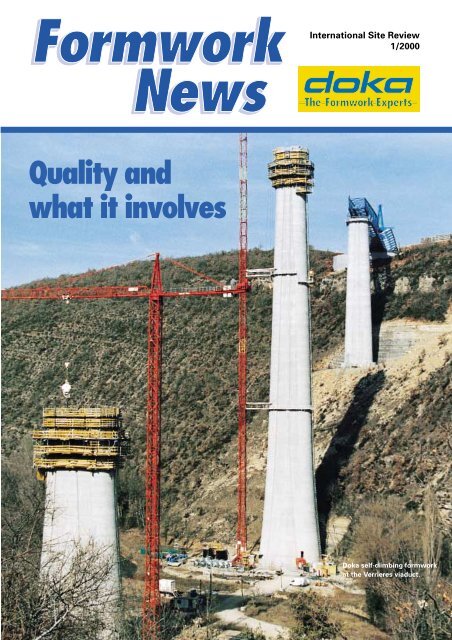

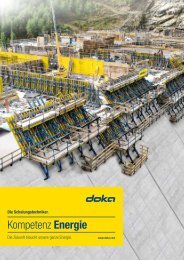
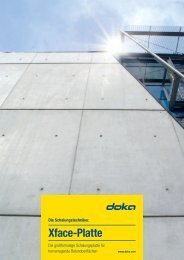

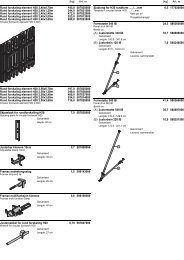
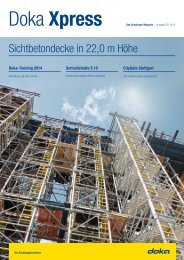
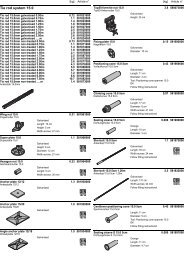
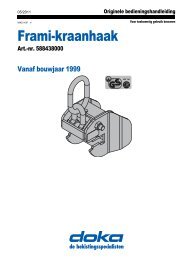
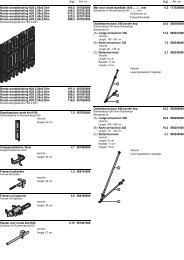

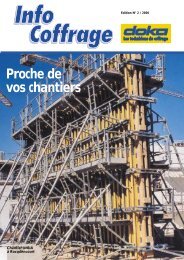
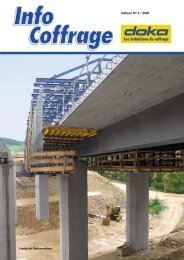
![n. articolo [kg] n. articolo [kg] Mensola diga D15 K 136,4 580630000 ...](https://img.yumpu.com/16362468/1/184x260/n-articolo-kg-n-articolo-kg-mensola-diga-d15-k-1364-580630000-.jpg?quality=85)

